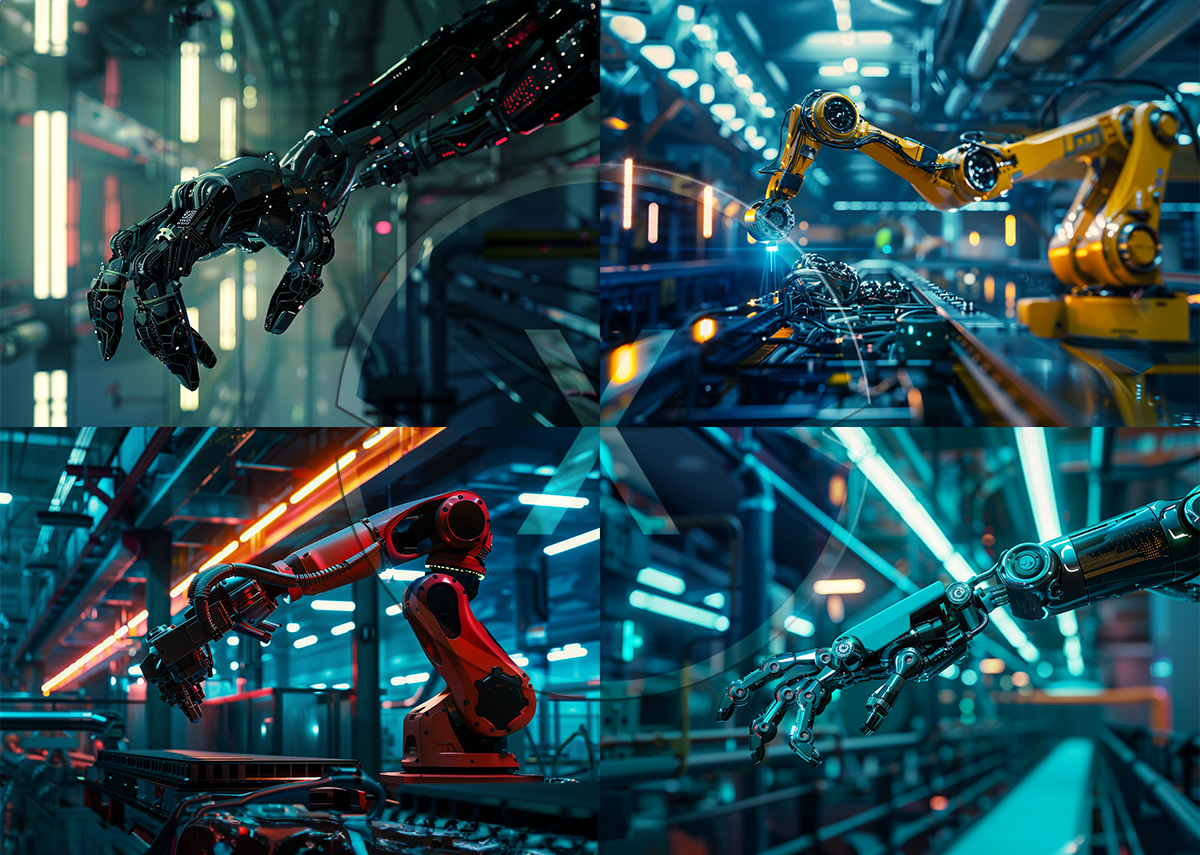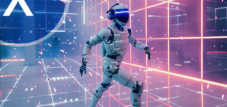
AI industrial solutions and robotics AI turbocharger – when speed is essential: The Hugging Face model repository and NVIDIA's microservices – Image: Xpert.Digital
🤖🏭 In the modern industrial landscape - The importance of robotics in industry
🧠🌐 Artificial intelligence (AI) is playing an increasingly important role in the modern industrial landscape. The field of industrial robotics, in particular, is benefiting significantly from the advancements made possible by AI technologies. Companies like Hugging Face and NVIDIA are leading the way in developing solutions that increase efficiency and flexibility in production. These technologies enable companies to meet the growing demands for speed and precision driven by global competition and technological progress.
Industry 4.0 is not just a buzzword. It marks a new era of industrial production characterized by the use of intelligent, networked systems. Robotics, in particular, plays a central role. Robots are capable of taking on complex tasks that would overwhelm human workers. At the same time, they are significantly more efficient and less prone to errors. These advantages make them an indispensable component of modern production.
Robot arms used in the automotive industry, for example, can perform thousands of welds per day with the highest precision and speed. Robots also ensure the fast and error-free assembly of delicate components in electronics manufacturing. Such applications are only possible thanks to the integration of advanced AI solutions.
📁🤓 Hugging Face: The model repository
Hugging Face is a leading company in the field of AI and has made a name for itself particularly with its model repository. This repository offers a wide variety of pre-trained models for diverse applications. For industry, the models in the areas of natural language processing (NLP) and computer vision are of particular interest.
Hugging Face's pre-trained models enable companies to quickly and efficiently integrate AI solutions into their existing systems. This is particularly important when developing new production processes or optimizing existing ones. By using pre-trained models, the time required for training from scratch is eliminated, and implementation can be significantly accelerated.
For example, NLP models can be used in logistics to automate communication between different systems. This can help make supply chains more efficient and prevent bottlenecks. In quality assurance, computer vision models can be used to detect defects in product batches early on and thus minimize waste.
🔍⛓️ NVIDIA and Microservices
NVIDIA is another giant in the field of AI development. While the company is primarily known for its graphics cards, it has also made significant progress in recent years in the area of AI-powered microservices. These microservices are small, independent applications that perform specific tasks within a larger system.
One of the strengths of microservices is their scalability. Companies can provide precisely the resources needed to complete a specific task and adjust them flexibly as required. This is ideal for industrial applications where demand can fluctuate significantly.
A concrete example of the use of NVIDIA microservices in industry is predictive maintenance. Sensors on machines continuously collect data about their condition. Based on this data, AI models, running as microservices, can predict potential failures. This allows maintenance work to be carried out before costly downtime occurs.
Another area of application is the real-time monitoring of production processes. By analyzing large amounts of data in real time, anomalies can be detected and corrected immediately. This significantly increases the efficiency and reliability of production.
🤝🛠️ Synergy effects through the combination of Hugging Face and NVIDIA
The combination of Hugging Face and NVIDIA technologies offers enormous potential for industrial applications. Hugging Face's pre-trained models can be integrated into NVIDIA's scalable microservices, enabling the development of highly specialized and efficient systems.
One example of this could be a quality assurance system in the manufacturing industry. Pre-trained computer vision models from Hugging Face could be used to detect production defects. These models could be embedded in NVIDIA microservices that operate in real time and immediately raise an alarm or stop the production line upon detecting a defect.
Similar synergies could be achieved in logistics. Hugging Face's language models could be integrated into NVIDIA's communication microservices to improve coordination between different logistics centers. This could lead to an even smoother and more efficient supply chain.
🔮🚀The future of industrial AI
The future of industrial AI looks promising. The integration of AI into industrial processes will continue to increase, offering even more opportunities for innovation. Key trends driving this development include the networking of machines (Internet of Things), the increasing availability of big data, and advances in algorithms and hardware.
One interesting area of development is the autonomous factory. Here, robots and other intelligent systems interact with each other, exchange data in real time, and optimize the production process without human intervention. This could lead to a revolution in the manufacturing industry, similar to the introduction of assembly line production in the early 20th century.
Another significant trend is personalized manufacturing. AI-driven systems could make it possible to consider individual customer requirements in real time and produce tailor-made products. This would represent a leap away from mass production towards customized manufacturing, without sacrificing efficiency.
⚠️🔧 Challenges and Solutions
Despite the many advantages, companies that want to integrate AI into industrial processes also face challenges. One of the biggest hurdles is data protection. The collected data must be protected from misuse, and companies must ensure compliance with applicable data protection laws.
Another problem is integration. Many companies already use a variety of different systems and technologies. Integrating new AI solutions into these existing systems can be complex and time-consuming.
Standards and open platforms can help here. The use of standardized interfaces and protocols facilitates the integration and collaboration of different systems. Open platforms also allow different vendors to develop compatible solutions, which means greater flexibility and choice for companies.
The combination of Hugging Face and NVIDIA technologies offers enormous potential for improving industrial processes. By using pre-trained models and scalable microservices, companies can increase their efficiency, reduce costs, and simultaneously improve quality. The challenges involved can be overcome through targeted measures and the use of open technologies. The future of industrial AI is promising and will undoubtedly bring many more exciting developments.
📣 Similar topics
- 🤖 Artificial Intelligence and Robotics in Industry 4.0
- 🚀 Efficiency and flexibility through AI: Success factors in production
- 🛠️ Robotics in Industry: Trends and Technologies
- 📚 Hugging Face: Pre-trained models for industrial applications
- 🖥️ NVIDIA Microservices: Scalable solutions for industry
- 🌟 Synergies between Hugging Face and NVIDIA: Optimized industrial processes
- 🔮 Future trends in industrial AI: Autonomous factories and more
- 🔍 Challenges of integrating AI into businesses
- 📡 Data protection in industrial AI: Measures and solutions
- ⛓️ Open platforms: Key to successful system integration
#️⃣ Hashtags: #ArtificialIntelligence #Industry40 #Robotics #HuggingFace #NVIDIA
🦾⚙️🔧 Humanoid Robotics: NVIDIA accelerates the development of humanoid robots with Extended Reality, AI and Omniverse (Metaverse)
Humanoid Robotics: NVIDIA is accelerating the development of humanoid robots with Extended Reality, AI and Omniverse (Metaverse) – Image: Xpert.Digital
A fascinating recent example is a video released by NVIDIA demonstrating the control of a robot using Apple Vision Pro. In this scenario, a person is in a kitchen controlling a robot by adopting the robot's perspective through the Vision Pro glasses. The hand movements captured by the glasses are transmitted to the robot, allowing the person to control it remotely. This enables applications such as preparing toast with honey, controlled by the person.
This technology has far-reaching implications, especially in areas where it can be dangerous for people, such as in buildings at risk of collapse or other hazardous environments. It's easy to imagine how this technology could be used in rescue missions or bomb disposal.
More about it here:
We are there for you - advice - planning - implementation - project management
Xpert.Digital - Pioneer Business Development
Smart Glasses & KI - XR/AR/VR/MR industry expert
Consumer metaverse or meta -verse in general
If you have any questions, further information and advice, please feel free to contact me at any time.
I would be happy to serve as your personal advisor.
You can contact me by filling out the contact form below or simply call me on +49 89 89 674 804 (Munich) .
I'm looking forward to our joint project.
Xpert.Digital - Konrad Wolfenstein
Xpert.Digital is a hub for industry with a focus on digitalization, mechanical engineering, logistics/intralogistics and photovoltaics.
With our 360° business development solution, we support well-known companies from new business to after sales.
Market intelligence, smarketing, marketing automation, content development, PR, mail campaigns, personalized social media and lead nurturing are part of our digital tools.
You can find out more at: www.xpert.digital - www.xpert.solar - www.xpert.plus

